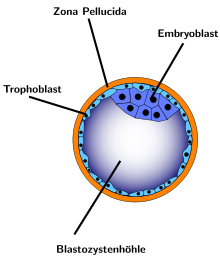- Trophoblast
-
Das Trophoblast ist die äußere Zellschicht einer Blastozyste und verbindet diese mit der Gebärmutterwand. Es bildet sich am 5. bis 12. Tag nach der Befruchtung aus Blastomere, weicht mittels Enzymen die Gebärmutterschleimhaut auf und kann sich so an ihr festsetzen.
Durch das Auflösen der Schleimhautzellen der Gebärmutter wird der Keim die erste Zeit ernährt. Während dieser Phase wächst der Trophoblast mit Hilfe seines Synzytiotrophoblastenanteils invasiv in die Gebärmutterschleimhaut ein, indem die betreffenden Zellen ihre Grenzen verlieren und dabei letztendlich unregelmäßig vernetzte Trabekel und Lakunen bilden (lakunäres Stadium, 8.–9. Tag). Das für den Vorgang notwendige Zellmaterial liefert der Zytotrophoblast, dies ist der um den Embryoblasten liegende Anteil des Trophoblasten.
Ab diesem Stadium treten nun die ersten zottenartigen Gebilde in Erscheinung, man spricht von den Primärzotten oder Villi. In diese dringen ab dem 12. Tag Zytotrophoblastenzellen ein, der Synzytiotrophoblastanteil wird ausgedünnt und bildet nur noch eine dünne Deckschicht. Ab diesem Stadium spricht man von den Sekundärzotten. Ab etwa dem 20. Tag dringt extraembryonales Mesoderm in die Sekundärzotten vor, in dem sich Blutgefäße bilden, welche Anschluss an die Gefäße des Haftstiels finden, und so die definitive vaskuläre Versorgung des Embryos sicherstellen.
Im weiteren Verlauf treten in diesen Tertiärzotten die sogenannten Hofbauer-Zellen (Makrophagen) auf, die das Zottenwachstum zusätzlich stimulieren und Fremdkörper phagozitieren. Diese nun wachsenden Zottenbäume bilden zusammen mit residuierenden mütterlichen Anteilen die Plazenta, die alle lebenswichtigen Funktionen für den aus der Keimscheibe entstehenden Embryo übernimmt.
Trophoblasten haben keine MHC-Klasse-1-Antigene.
Weblinks

Bitte den Hinweis zu Gesundheitsthemen beachten!
Wikimedia Foundation.

